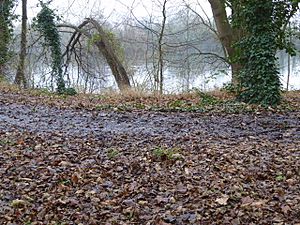Wraysbury No 1 Gravel Pit facts for kids
| Site of Special Scientific Interest | |
 |
|
| Area of Search | Berkshire |
|---|---|
| Interest | Biological |
| Area | 58.0 hectares (143 acres) |
| Notification | 1999 |
| Location map | Magic Map |
Wraysbury No 1 Gravel Pit is a very special natural area in Wraysbury, Berkshire. It covers about 58 hectares (143 acres) of land and water. This site is so important for wildlife that it is called a Site of Special Scientific Interest. It is also part of a larger area known as the South West London Waterbodies. This bigger area is recognized internationally for its amazing birds.
The main part of the site is a large lake. This lake was created a long time ago when people dug out gravel. Over many years, plants and animals moved in. Now, it is a beautiful and mature home for lots of different creatures.
Contents
How Wraysbury Pit Was Formed
This special lake started as a big hole in the ground. In the 1920s and 1930s, people dug up sand and gravel here. This gravel was used for building things like roads and houses. The area is near the River Thames, which naturally has lots of sand and gravel.
Once the digging stopped, the empty pits filled up with water. This water came from rain and the surrounding land. Slowly, these flooded pits turned into lakes. Nature then began to take over. Plants started to grow, and animals found new homes. By the 1930s, the lake had grown quite large. Today, it is also a popular spot for fishing, especially for fish like carp.
A Home for Wildlife
Wraysbury No 1 Gravel Pit is important because it provides a safe place for many different animals and plants. It has a deep lake with steep sides. Around the lake, there are areas with bushes and trees. These different parts create a perfect habitat for various species.
Birds of the Lake
This site is especially important for birds, particularly in winter. Many water birds come here to feed and rest.
- The gadwall is a type of duck that visits in large numbers during winter.
- Other ducks you might see include the northern shoveler, the Smew, the tufted duck, the common pochard, and the common goldeneye.
- Larger water birds like the great crested grebe, the great cormorant, and the Eurasian coot also spend their winters here.
Birds of the Land
The land around the lake is also home to many birds. These birds live in the trees and bushes.
- You might spot a small bird called the Eurasian treecreeper climbing up tree trunks.
- The garden warbler sings its beautiful song from the bushes.
- The great spotted woodpecker can be heard tapping on trees.
- A fast-flying bird of prey, the Eurasian hobby, also hunts here.
Plants of the Grassland
There are also areas of wild grassland at Wraysbury No 1 Gravel Pit. These areas are full of interesting wildflowers.
- You can find plants like lesser knapweed with its purple flowers.
- The delicate white flowers of wild carrot grow here.
- Bright yellow flowers of meadow vetchling add color.
- Another yellow flower, common bird's-foot trefoil, is also present.

